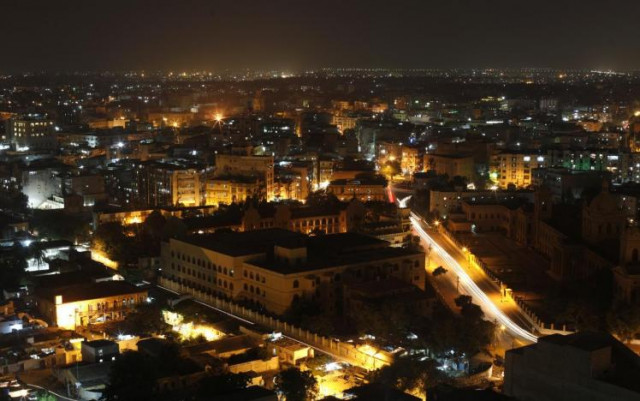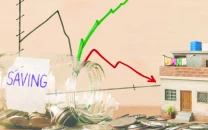Country witnesses no major change in political, economic structure
Corrupt governance system, land-owning political class keep economic reforms at bay

View of city skyline at dusk in Karachi. PHOTO: REUTERS
Pakistan, once a regional economic power in the 1960s, could not realise its potential and fell behind its East Asian fellow countries. Political instability, religious fundamentalism, sectarian violence, ethnic differences, terrorism and regional economic disparities have made the country unstable which has contributed towards an unsatisfactory economic condition.
External influences have also been an important factor in shaping Pakistan’s political and economic structure. Pakistan allied with the US against communism and this contributed to creating an elite capitalist state in which large landowners and industrialists dominated the political and economic scenario along with the military and bureaucracy.
Similarly, the IMF and World Bank-led structural adjustment programmes put Pakistan on the path of liberalisation and privatisation which resulted in a more powerful economic elite consisting of industrialists and politicians.
DG ISPR should refrain from commenting on economic issues: Ahsan Iqbal
The result of these pro-capitalism programmes is that income inequality has grown over the period with the gap widening across the country.
The lower middle classes have almost no say in politics due to a lack of education and awareness of their civil and political rights. Their existence, as a result, is largely subsistence-based and day-to-day.
The long enmity with India has also had a major impact on the country’s economy. A substantial share of resources and funds has been directed towards defence to secure the country against any military threat from India. It is also a cause of not having trade relations with India, which could have proved beneficial for Pakistan in economic terms.
Budget deficit
Pakistan’s experience with fiscal management has been quite ineffective. The success of monetary policy depends heavily on fiscal support and its prudence. Otherwise, monetary policy is overburdened.
The federal budget deficit, as conventionally defined, has fluctuated around 5% of GDP over the last two decades. In the 1980s, it was 7.1% excluding grants and 6.4% including grants. In the last decade, the deficit-to-GDP ratio decreased to an average of 4%.
The real issue in fiscal management is the decomposition of government expenditure on development versus current expenditure.
While development spending generates economic activity and reduces the overall debt burden, current spending only adds more to the debt burden. Over the decades, our internal and external debt has increased.
It has been claimed that a huge amount of money had been spent by vested interests to resist reformed general sales tax (RGST), which would have led to the “documentation of the economy” and “better tax compliance”.
The Federal Board of Revenue has failed to improve the tax-to-GDP ratio, which dropped to 8% in FY16 from 12.5% in FY02.
Due to inept leadership and corrupt government structures, the country is piling up huge debts. Total foreign and domestic debt at the beginning of 2011 had reached almost $130 billion. Our financial managers are caught in a dilemma.
Security-economy link: ‘Sky high debt’ worries COAS
On the one hand, there is mounting pressure from donors to reduce the fiscal deficit through improved collections while on the other hand, the ailing economy is not in a position to meet the growing revenue targets.
There is a need to raise the tax-to-GDP ratio to a minimum of 13-15%. This should be vigorously implemented in the under-taxed sectors and undocumented areas of the economy, eg agriculture, services and stock market.
Our dependence on import-related indirect taxes is a significant risk to the economy.
Bureaucracy
In Pakistan, three important organisational branches that affect macroeconomic policy and growth are the bureaucracy (Ministry of Finance, the Planning Commission), the central bank and parliament. Institutional change must occur first in these organisations.
If government interventions are necessary, market pricing should be given priority with a clear focus on providing transparency and accountability. The state can still provide a long-term vision and direction to the economy, but this is only possible if both governance and public institutions are strong.
In a nutshell, Pakistan has not developed politically and economically in 70 years because of historical bureaucratic structure and an elite landowning political class. The middle class has been a junior partner with bureaucracy for its own vested economic interests and due to this there has been no significant positive change in the political and economic structure.
Economy on the verge of bankruptcy due to PML-N’s policies: Zardari
Western influences have also played a part in strengthening the bureaucratic class because of their particular interests and their funds and aid have been used for political purposes rather than economic growth.
The widespread violence in the aftermath of Soviet-Afghan war and US-led invasion of Afghanistan still haunts the country. A friendly neighbour in the form of India could have been a blessing but on both sides of the border it never happened to be a good fortune.
The writer is a researcher at the Sustainable Development Policy Institute
Published in The Express Tribune, October 16th, 2017.
Like Business on Facebook, follow @TribuneBiz on Twitter to stay informed and join in the conversation.



















COMMENTS
Comments are moderated and generally will be posted if they are on-topic and not abusive.
For more information, please see our Comments FAQ